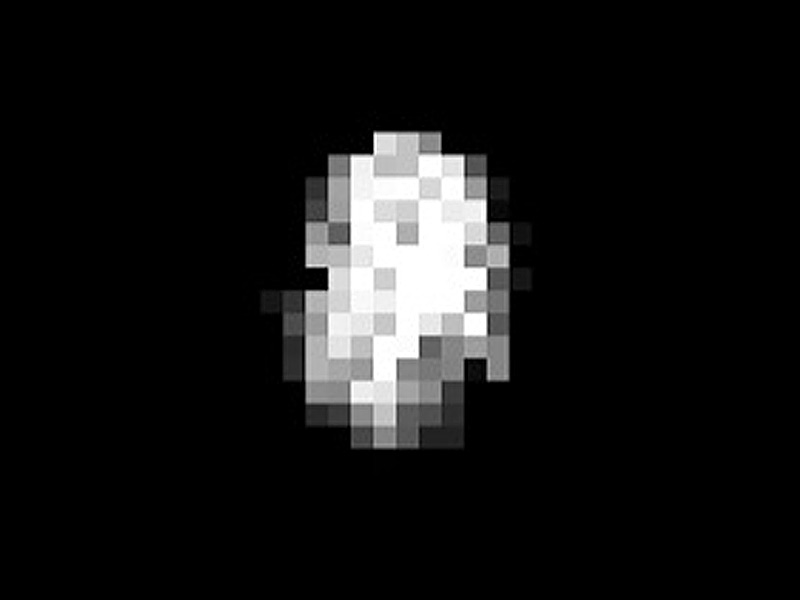Asteroid 2007 TU24 Passes the Earth

소행성 2007 TU24 가 지구에 아무 위험을 끼치지 않고 무사히 지나갔다. 이 소행성은 길이가 250m 정도 되며, 달의 궤도보다 약간 먼 거리로 지나쳐갔다. 하지만 이 일은 그다지 놀라운 일은 아닌데, 매일 작은 크기의 소행성들이 지구로 돌진하고 있으며 2003년에는 버스 크기의 소행성이 달 보다 더 안쪽 궤도로 다가왔고, 이 소행성이 다행이도 지구를 지나쳐 갔을 때, 천문학자들은 마침내 그 소행성을 발견할 수 있었다. 그 소행성과 다르게 TU24 는 크기가 컸기 때문에 빠른 시일에 발견 할 수 있었다. 만약 TU24 크기의 소행성이 육지 충돌한다면, 진도 7의 지진과 함께 도시 크기의 크레이터가 생길 것이다. 만약 이 소행성이 바다와 충돌한다면 더 위험한 일이 생기는데, 이는 거대한 쓰나미를 불러일으켜 큰 타격을 줄 것이다.
이 전파(radar) 사진은 2일 전에 찍혔으며, 아레시보 전파 망원경(Arecibo Radio Telescope) 에서 발사된 레이다는 소행성과 반사되어 남 버지니아에 위치한 그린뱅크(Green bank) 버드 전파 망원경(Byrd Radio Telescope)에게 포착되었다. 위 사진은 TU24 가 불규칙적이고 타원형의 모양을 가지고 있음을 보여준다. TU24 는 3개월 전이야 발견되었는데, 이는 아직도 태양계에 지구를 위협하는 발견되지 않은 많은 소행성들이 있다는 사실을 가르쳐 준다. TU24 와 같은 물체는 포착하기 매우 힘든데 왜냐면 이는 너무 희미하고 매우 빠르게 움직이기 때문이다. 하지만 위와 같은 물체를 찾아내는 인간의 능력은 예전보다 매우 향상되었다.
Asteroid 2007 TU24 passed by the Earth yesterday, posing no danger. The space rock, estimated to be about 250 meters across, coasted by just outside the orbit of Earth's Moon. The passing was not very unusual -- small rocks strike Earth daily, and in 2003 a rock the size of a bus passed inside the orbit of the Moon, being detected only after passing. TU24 was notable partly because it was so large. Were TU24 to have struck land, it might have caused a magnitude seven earthquake and left a city-sized crater. A perhaps larger danger would have occurred were TU24 to have struck the ocean and raised a large tsunami. This radar image was taken two days ago. The Arecibo Radio Telescope in Puerto Rico broadcast radar that was reflected by the asteroid and then recorded by the Byrd Radio Telescope in Green Bank, West Virginia. The resulting image shows TU24 to have an oblong and irregular shape. TU24 was discovered only three months ago, indicating that other potentially hazardous asteroids might lurk in our Solar System currently undetected. Objects like TU24 are hard to detect because they are so faint and move so fast. Humanity's ability to scan the sky to detect, catalog, and analyze such objects has increased notably in recent years.

소행성 2007 TU24 가 지구에 아무 위험을 끼치지 않고 무사히 지나갔다. 이 소행성은 길이가 250m 정도 되며, 달의 궤도보다 약간 먼 거리로 지나쳐갔다. 하지만 이 일은 그다지 놀라운 일은 아닌데, 매일 작은 크기의 소행성들이 지구로 돌진하고 있으며 2003년에는 버스 크기의 소행성이 달 보다 더 안쪽 궤도로 다가왔고, 이 소행성이 다행이도 지구를 지나쳐 갔을 때, 천문학자들은 마침내 그 소행성을 발견할 수 있었다. 그 소행성과 다르게 TU24 는 크기가 컸기 때문에 빠른 시일에 발견 할 수 있었다. 만약 TU24 크기의 소행성이 육지 충돌한다면, 진도 7의 지진과 함께 도시 크기의 크레이터가 생길 것이다. 만약 이 소행성이 바다와 충돌한다면 더 위험한 일이 생기는데, 이는 거대한 쓰나미를 불러일으켜 큰 타격을 줄 것이다.
이 전파(radar) 사진은 2일 전에 찍혔으며, 아레시보 전파 망원경(Arecibo Radio Telescope) 에서 발사된 레이다는 소행성과 반사되어 남 버지니아에 위치한 그린뱅크(Green bank) 버드 전파 망원경(Byrd Radio Telescope)에게 포착되었다. 위 사진은 TU24 가 불규칙적이고 타원형의 모양을 가지고 있음을 보여준다. TU24 는 3개월 전이야 발견되었는데, 이는 아직도 태양계에 지구를 위협하는 발견되지 않은 많은 소행성들이 있다는 사실을 가르쳐 준다. TU24 와 같은 물체는 포착하기 매우 힘든데 왜냐면 이는 너무 희미하고 매우 빠르게 움직이기 때문이다. 하지만 위와 같은 물체를 찾아내는 인간의 능력은 예전보다 매우 향상되었다.
Asteroid 2007 TU24 passed by the Earth yesterday, posing no danger. The space rock, estimated to be about 250 meters across, coasted by just outside the orbit of Earth's Moon. The passing was not very unusual -- small rocks strike Earth daily, and in 2003 a rock the size of a bus passed inside the orbit of the Moon, being detected only after passing. TU24 was notable partly because it was so large. Were TU24 to have struck land, it might have caused a magnitude seven earthquake and left a city-sized crater. A perhaps larger danger would have occurred were TU24 to have struck the ocean and raised a large tsunami. This radar image was taken two days ago. The Arecibo Radio Telescope in Puerto Rico broadcast radar that was reflected by the asteroid and then recorded by the Byrd Radio Telescope in Green Bank, West Virginia. The resulting image shows TU24 to have an oblong and irregular shape. TU24 was discovered only three months ago, indicating that other potentially hazardous asteroids might lurk in our Solar System currently undetected. Objects like TU24 are hard to detect because they are so faint and move so fast. Humanity's ability to scan the sky to detect, catalog, and analyze such objects has increased notably in recent years.
'Astronomy > etc' 카테고리의 다른 글
| 우주 정거장에 설치된 콜럼버스 실험실 - Columbus Laboratory Installed on Space Station (0) | 2008.02.20 |
|---|---|
| 거대한 쌍안 망원경 - Large Binocular Telescope (0) | 2008.02.16 |
| 39A 발사대 위에 있는 아틀란티스 호 - Atlantis on Pad 39A (0) | 2008.02.09 |
| 첫번째 탐사선 - The First Explorer (0) | 2008.02.01 |
| Pic du Midi 의 겨울밤 - Winter Night at Pic du Midi (0) | 2008.01.26 |



